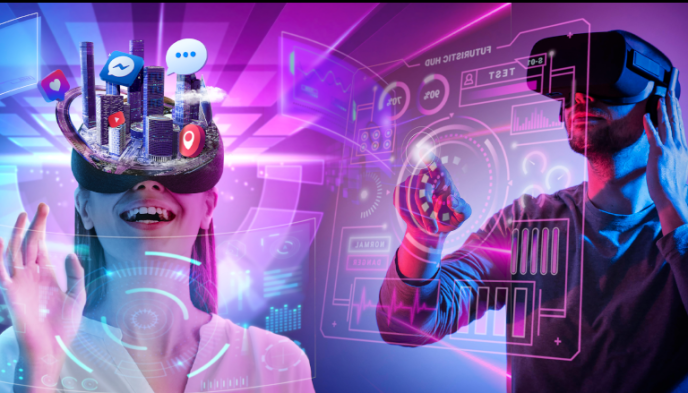Exploring the Metaverse: The Next Digital Frontier
The metaverse—a term that once seemed like a distant concept from science fiction—is rapidly becoming the next frontier in the digital world. As technology continues to evolve, the metaverse is positioned to redefine how we interact, socialize, work, and live. But what exactly is the metaverse, and why is it generating so much excitement? Let’s explore the potential of this next digital evolution.
What is the Metaverse?
The metaverse can be described as a virtual universe, a network of interconnected digital spaces where users can interact with each other and digital environments in real time. It’s a fully immersive, persistent, and shared virtual world that allows for a variety of experiences, from gaming to socializing, working, learning, and even shopping. Unlike the internet as we know it today, which is mainly composed of websites and apps we visit on screens, the metaverse aims to be an interactive and immersive three-dimensional space.
This world isn’t just built on existing platforms but combines virtual reality (VR), augmented reality (AR), 3D worlds, and blockchain technologies to create an expansive, continuously evolving ecosystem. Major tech companies, including Meta (formerly Facebook), Microsoft, and Nvidia, have poured resources into developing the metaverse, signaling its potential to revolutionize the way we experience the digital world.
See also: Cybersecurity: Protecting the Digital World
Key Technologies Driving the Metaverse
- Virtual Reality (VR) and Augmented Reality (AR): At the heart of the metaverse are immersive experiences. VR headsets, such as the Oculus Rift or HTC Vive, allow users to enter completely virtual worlds. AR, on the other hand, overlays digital information onto the real world, creating hybrid environments. These technologies provide the sensory experiences necessary for full immersion into the metaverse.
- Blockchain and Cryptocurrencies: The metaverse is expected to operate on decentralized networks, where blockchain technology plays a crucial role. Blockchain can ensure secure, transparent transactions and help manage virtual assets like NFTs (non-fungible tokens), which are unique digital items or property in the metaverse. Cryptocurrencies will likely be the primary medium for transactions, powering everything from virtual real estate to digital art.
- Artificial Intelligence (AI): AI enhances the metaverse by enabling smarter environments and more interactive experiences. Virtual assistants, NPCs (non-playable characters), and even AI-driven content creation can populate the metaverse, making it dynamic and responsive to user actions.
- Cloud Computing: The metaverse relies heavily on cloud infrastructure to provide the scalability required for billions of users and vast, interconnected environments. Cloud computing ensures that users can access the metaverse from any device, whether it’s a high-powered gaming PC or a mobile phone.
Applications and Use Cases of the Metaverse
- Entertainment and Gaming: The metaverse’s roots are firmly planted in the world of gaming. Platforms like Roblox and Fortnite have pioneered shared virtual spaces where users can play, socialize, and even attend live events. But the potential is far greater. Imagine exploring vast, open-world games that extend beyond traditional console or PC gaming, where you can interact with friends, participate in live events, and even create your own content in real-time.
- Socialization and Virtual Communities: One of the most exciting aspects of the metaverse is its potential to transform social media and virtual communities. Instead of communicating through text or images on social media platforms, users will be able to interact with friends, family, and strangers in 3D virtual spaces. Think of it as a digital version of meeting someone at a park or a café, except it’s happening in a fully immersive, virtual setting.
- Business and Workspaces: The metaverse is poised to change the nature of work. Virtual offices, meetings, and collaboration tools will replace traditional workplace setups. Companies could use the metaverse to bring remote teams together in a virtual space, where employees interact as avatars and collaborate in ways that go beyond video calls. The possibility of virtual conferences, trade shows, and even real-time brainstorming sessions will offer new dimensions to business operations.
- Education and Learning: The metaverse offers a revolutionary way to learn. Imagine attending a lecture in a virtual classroom, where you’re not just listening to a teacher, but interacting with simulations, conducting experiments, and collaborating with other students in a fully immersive environment. The metaverse could help break down barriers to education, providing students from around the world with access to the best teachers, resources, and experiences.
- Retail and Virtual Economy: E-commerce in the metaverse could become a game-changer. Virtual stores, showrooms, and marketplaces will allow customers to explore products in 3D before purchasing them, enhancing the online shopping experience. Virtual items, from digital clothing to NFTs and virtual real estate, are already being bought and sold, creating a new economy within the metaverse.
Challenges and Ethical Considerations
While the potential benefits of the metaverse are undeniable, several challenges and ethical considerations need to be addressed:
- Privacy and Security: As users immerse themselves more deeply in virtual spaces, they will generate vast amounts of data. Protecting this data from breaches and misuse will be crucial. Additionally, the risk of identity theft and cyberattacks in virtual environments is a concern that needs to be tackled.
- Digital Divide: Access to the metaverse will require specific hardware (VR headsets, high-speed internet, etc.) that may not be available to everyone, leading to concerns about equity. Ensuring that the metaverse is accessible to people of all backgrounds and financial means will be a major challenge.
- Mental Health and Well-being: The immersive nature of the metaverse raises questions about its impact on users’ mental health. Prolonged exposure to virtual environments could lead to feelings of isolation, addiction, or disconnection from the real world. It’s essential to balance the benefits of virtual experiences with real-world interactions and self-care.
- Content Moderation and Governance: As with any online platform, the metaverse will require a system for monitoring content and ensuring that users behave ethically. Virtual harassment, abuse, and the spread of misinformation could become significant issues in these new spaces. A robust governance framework must be established to regulate activities in the metaverse.
The Future of the Metaverse
The metaverse is still in its early stages, but its potential is vast. It has the power to transform not only the way we interact with digital technology but also how we live and work. As technology continues to advance, the metaverse will evolve and expand, offering limitless possibilities for individuals and organizations alike.
We are only beginning to scratch the surface of what the metaverse can offer, and as its development progresses, it will undoubtedly shape the future of the internet and our digital lives. Whether it’s for work, play, education, or business, the metaverse promises to be a transformative experience that will redefine the boundaries of our digital reality.
In the coming years, expect to see an explosion of new applications, platforms, and experiences that will push the limits of what we thought was possible in the digital world. The metaverse is no longer just a concept; it’s the future, and it’s here to stay.





